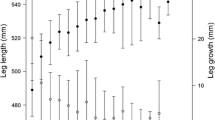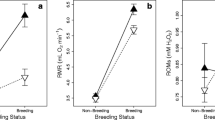Abstract
Life history theory predicts trade-offs in allocation between survival, maintenance, growth, and reproduction, especially when resources are scarce. Individual variation in resource acquisition can affect trade-offs, but is often unaccounted for. We quantified the fitness costs of reproduction, accounting for environmental conditions, maternal characteristics and individual variation. We analyzed 10 years of data from marked kangaroos to evaluate how reproductive allocation affected annual mass change and skeletal growth, subsequent fecundity and weaning success, and survival, accounting for maternal mass or size and forage availability. Through repeated measurements of 76–91 females, we investigated how trade-offs varied within and between individuals, assessing whether individual variation could mask population-level trade-offs. In poor environments, females that weaned an offspring lost mass. Females that nursed an offspring for > 7 months had reduced skeletal growth. Females that did not gain mass over the previous 12 months rarely reproduced, especially if they had nursed an offspring for > 7 months the previous year. Reproductive allocation had no effect on weaning success, which was very low, and did not affect maternal survival, suggesting a conservative strategy. Disentangling within- and between-individual responses revealed trade-offs within individuals, but because individuals did not vary in their responses to earlier effort, these trade-offs did not drive population trends. The interacting effects of environmental conditions, maternal characteristics and individual variation on allocation trade-offs demonstrate the importance of long-term monitoring for understanding life history variations in changing environments.




Similar content being viewed by others
Data availability statement
The doi for our data is https://doi.org/10.17605/OSF.IO/X73H
Change history
14 May 2020
Unfortunately, the online publication contained an error in the “Data availability statement” and it is corrected by this erratum.
References
Andersen R, Gaillard J-M, Linnell JDC, Duncan P (2000) Factors affecting maternal care in an income breeder, the European roe deer. J Anim Ecol 69:672–682
Australian Bureau of Meteorology (2019) Australian Government, Bureau of Meteorology, Climate data online. http://www.bom.gov.au/. Accessed 24 Aug 2019
Bårdsen BJ, Næss MW, Tveraa T et al (2014) Risk-sensitive reproductive allocation: fitness consequences of body mass losses in two contrasting environments. Ecol Evol 4:1030–1038
Barton K (2018) MuMin: multi-model inference. https://CRAN.R-project.org/package=MuMIn
Bates D, Mächler M, Bolker BM, Walker SC (2015) Fitting linear mixed-effects models using lme4. J Stat Softw 67:1–48
Bergeron P, Baeta R, Pelletier F et al (2011) Individual quality: tautology or biological reality? J Anim Ecol 80:361–364
Bolker BM (2019) GLMMs FAQ. http://bbolker.github.io/mixedmodels-misc/glmmFAQ.html#singular-models-random-effect-variances-estimated-as-zero-or-correlations-estimated-as-1. Accessed 24 Aug 2019
Boretto JM, Cabezas-Cartes F, Ibargüengoytía NR (2015) Energy allocation to growth and reproduction in a viviparous lizard endemic to the highlands of the Andes, Argentina. J Zool 297:77–86
Brooks RJ, Shilton CM, Brown GP, Quinn NWS (2008) Body size, age distribution, and reproduction in a northern population of wood turtles (Clemmys insculpta). Can J Zool 70:462–469
Burnham KP, Anderson D (2002) Model selection and multimodel inference. Springer, New York
Burnham KP, Anderson DR, Huyvaert KP (2011) AIC model selection and multimodel inference in behavioral ecology: some background, observations, and comparisons. Behav Ecol Sociobiol 65:23–35
Chung Y, Rabe-Hesketh S, Dorie V et al (2013) A nondegenerate penalized likelihood estimator for variance parameters in multilevel models. Psychometrika 78:685–709
Clutton-Brock TH, Guinness FE, Albon SD (1983) The costs of reproduction to red deer hinds. J Anim Ecol 52:367–383
Clutton-Brock TH, Albon SD, Guinness FE (1989) Fitness costs of gestation and lactation in wild mammals. Nature 337:260–262
Cork SJ, Dove H (1989) Lactation in the Tammar Wallaby (Macropus Eugenii). II. Intake of milk components and maternal allocation of energy. J Zool 219:399–409
Costa DP (1993) The relationship between reproductive and foraging energetics and the evolution of Pinnipedia. Zool Symp Zool Soc Lond 66:293–314
Davis NE, Forsyth DM, Coulson G (2010) Facilitative interactions between an exotic mammal and native and exotic plants: Hog deer (Axis porcinus) as seed dispersers in south-eastern Australia. Biol Invasions 12:1079–1092
Festa-Bianchet M (1998) Condition-dependent reproductive success in bighorn ewes. Ecol Lett 1:91–94
Festa-Bianchet M, Jorgenson JT (1998) Selfish mothers: reproductive expenditure and resource availability in bighorn ewes. Behav Ecol 9:144–150
Festa-Bianchet M, Douhard M, Gaillard JM, Pelletier F (2017) Successes and challenges of long-term field studies of marked ungulates. J Mammal 98:612–620
Festa-Bianchet M, Côté SD, Hamel S, Pelletier F (2019) Long-term studies of bighorn sheep and mountain goats reveal fitness costs of reproduction. J Anim Ecol 88:1118–1133
Gaillard J-M, Festa-Bianchet M, Yoccoz NG (1998) Population dynamics of large herbivores: variable recruitment with constant adult survival. Trends Ecol Evol 13:58–63
Gélin U, Coulson G, Festa-Bianchet M (2015a) Heterogeneity in reproductive success explained by individual differences in bite rate and mass change. Behav Ecol 27:777–783
Gélin U, Wilson ME, Coulson G, Festa-Bianchet M (2015b) Experimental manipulation of female reproduction demonstrates its fitness costs in kangaroos. J Anim Ecol 84:239–248
Gélin U, Wilson ME, Cripps J et al (2016) Individual heterogeneity and offspring sex affect the growth–reproduction trade-off in a mammal with indeterminate growth. Oecologia 180:1127–1135
Glass R, Forsyth DM, Coulson G, Festa-Bianchet M (2015) Precision, accuracy and bias of walked line-transect distance sampling to estimate eastern grey kangaroo population size. Wildl Res 42:633–641
Graham MH (2003) Confronting multicollinearity in cological multiple regression. Ecology 84:2809–2815
Green B, Newgrain K, Merchant J (1980) Changes in milk composition during lactation in the tammar wallaby (Macropus eugenii). Aust J Biol Sci 33:35–42
Hamel S, Côté SD (2009) Foraging decisions in a capital breeder: trade-offs between mass gain and lactation. Oecologia 161:421–432
Hamel S, Côté SD, Gaillard J-M, Festa-Bianchet M (2009a) Individual variation in reproductive costs of reproduction: high-quality females always do better. J Anim Ecol 78:143–151
Hamel S, Gaillard J-M, Festa-Bianchet M, Côté SD (2009b) Individual quality, early-life conditions, and reproductive success in contrasted populations of large herbivores. Ecology 90:1981–1995
Hamel S, Côté SD, Festa-Bianchet M (2010) Maternal characteristics and environment affect the costs of reproduction in female mountain goats. Ecology 91:2034–2043
Heesen M, Rogahn S, Ostner J, Schülke O (2013) Food abundance affects energy intake and reproduction in frugivorous female Assamese macaques. Behav Ecol Sociobiol 67:1053–1066
Helle S (2008) A tradeoff between reproduction and growth in contemporary Finnish women. Evol Hum Behav 29:189–195
Hurvich CM, Tsai C-L (1989) Regression and time series model selection in small samples. Biometrika 76:297–307
Jönsson KI (1997) Capital and income breeding as alternative tactics of resource use in reproduction. Oikos 78:57–66
Karkach AS (2006) Trajectories and models of individual growth. Demogr Res 15:347–400
King WJ, Goldizen AW (2016) Few sex effects in the ontogeny of mother-offspring relationships in eastern grey kangaroos. Anim Behav 113:59–67
King WJ, Wilson ME, Allen T et al (2011) A capture technique for free-ranging eastern grey kangaroos (Macropus giganteus) habituated to humans. Aust Mammal 33:47–51
Kirkpatrick TH (1965) Studies on the Macropodidae in Queensland. 2. Age estimation in the grey kangaroo, the red kangaroo, the eastern wallaroo and the red-necked wallaby, with notes on dental abnormalities. Queensl J Agric Anim Sci 22:301–317
Lang SLC, Iverson SJ, Bowen WD (2009) Repeatability in lactation performance and the consequences for maternal reproductive success in grey seals. Ecology 90:2513–2523
Leivesley JA, Bussière LF, Pemberton JM et al (2019) Survival costs of reproduction are mediated by parasite infection in wild Soay sheep. Ecol Lett 22:1203–1213
Lenth (2018) emmeans: Estimated Marginal Means, aka Least-Squares Means. https://CRAN.R-project.org/package=emmeans
MacKay A, Forsyth DM, Coulson G, Festa-Bianchet M (2018) Maternal resource allocation adjusts to timing of parturition in an asynchronous breeder. Behav Ecol Sociobiol 72:7
Martin JGA, Festa-Bianchet M (2010) Bighorn ewes transfer the costs of reproduction to their lambs. Am Nat 176:414–423
Morano S, Stewart KM, Sedinger JS et al (2013) Life-history strategies of North American elk: trade-offs associated with reproduction and survival. J Mammal 94:162–172
Moyes K, Morgan B, Morris A et al (2011) Individual differences in reproductive costs examined using multi-state methods. J Anim Ecol 80:456–465
Nussey DH, Wilson AJ, Brommer JE (2007) The evolutionary ecology of individual phenotypic plasticity in wild populations. J Evol Biol 20:831–844
Poole WE (1973) A study of breeding in grey kangaroos, Macropus giganteus Shaw and M. fuliginosus (Desmarest), in central New South Wales. Aust J Zool 21:183–212
Poole WE (1975) Reproduction in two species of grey kangaroos, Macropus giganteus Shaw and Macropus fuliginosus (Desmarest). II. Gestation, parturition and pouch life. Aust J Zool 23:333–353
Poole WE, Carpenter SM, Wood JT (1982) Growth of grey kangaroos and the reliability of age determination from body measurements I. The eastern grey kangaroo, Macropus giganteus. Aust Wildl Res 9:9–20
Quesnel L, King WJ, Coulson G, Festa-Bianchet M (2018) Tall young females get ahead: size-specific fecundity in wild kangaroos suggests a steep trade-off with growth. Oecologia 186:59–71
Stearns SC (1992) The evolution of life histories. Oxford University Press, Oxford
Therrien J-F, Côté SD, Festa-Bianchet M, Ouellet J-P (2008) Maternal care in white-tailed deer: trade-off between maintenance and reproduction under food restriction. Anim Behav 75:235–243
Thomas L, Buckland ST, Rexstad EA et al (2010) Distance software: design and analysis of distance sampling surveys for estimating population size. J Appl Ecol 47:5–14
Toïgo C, Gaillard J-M, Gauthier D et al (2002) Female reproductive success and costs in an alpine capital breeder under contrasting environments. Écoscience 9:427–433
Tyndale-Biscoe CH, Janssens PA (1988) The develo** marsupial. Springer, Berlin
van de Pol M, Wright J (2009) A simple method for distinguishing within- versus between-subject effects using mixed models. Anim Behav 77:753–758
van Noordwijk AJ, de Jong G (1986) Acquisition and allocation of resources: their influence on variation in life history tactics. Am Nat 128:137–142
Weladji RB, Loison A, Gaillard JM et al (2008) Heterogeneity in individual quality overrides costs of reproduction in female reindeer. Oecologia 156:237–247
Acknowledgements
We thank Graeme Coulson, Naomi Davis, Wendy King and all students and field assistants who helped with fieldwork. W. King and G. Coulson aged dead kangaroos using the molar index. We are grateful to Parks Victoria, Wilsons Promontory National Park staff and the University of Melbourne for logistic support. Funding was provided by the Natural Sciences and Engineering Research Council of Canada (Discovery Grant to Marco Festa-Bianchet) and by Bishop’s University (Senate Research Committee grant to W. King). We thank Audrey Bourret, François Rousseu and Limoilou-Amélie Renaud for statistical advice. We are also grateful to L.-A. Renaud, W. King and two anonymous reviewers for comments on previous manuscript versions. Animal handling was approved by the Animal Care Committee of the Université de Sherbrooke (protocol MFB-2016-01) and by the Animal Ethics Committee of the University of Melbourne (approval 1312902.1). Field research was conducted under the authority of permits 1007062 and 10008630 of the Victoria Department of Environment, Land, Water and Planning.
Author information
Authors and Affiliations
Contributions
PT conceived the idea; PT, DMF and MFB collected the data; PT analysed the data and wrote the first draft; all authors contributed substantially to revisions.
Corresponding author
Additional information
Communicated by Mathew Samuel Crowther.
Electronic supplementary material
Below is the link to the electronic supplementary material.
Rights and permissions
About this article
Cite this article
Toni, P., Forsyth, D.M. & Festa-Bianchet, M. Forage availability and maternal characteristics affect costs of reproduction in a large marsupial. Oecologia 193, 97–107 (2020). https://doi.org/10.1007/s00442-020-04653-5
Received:
Accepted:
Published:
Issue Date:
DOI: https://doi.org/10.1007/s00442-020-04653-5




